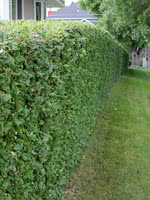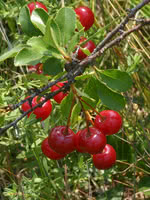Mon-Fri 9am - 5pm Mountain time
Peking Cotoneaster vs Cutie Pie Sour Cherry
Cotoneaster acutifolia
Prunus cerasus Cutie Pie
NOT AVAILABLE THIS SEASON - MIGHT RETURN
NOT AVAILABLE THIS SEASON - MIGHT RETURN
Peking Cotoneaster is a medium-sized shrub that is well adapted to colder climates. Best suited for use as a hedge, Peking Cotoneaster has dark green foliage that turns a stunning reddish orange in the fall.
Hardy fruit guru, Bernie Nikolai (DBG Fruit Growers), has started to recommend grafting hardy pear varieties to Peking Cotoneaster after his experiences were successful and produced fruit faster than other rootstocks. Remember to leave some nurse limbs if you try this.
The Cutie Pie Sour Cherry produces fruit that are sweeter than other sour cherry varieties. Good for fresh eating and for making jams and jellies. They are small in stature (shrub like) and multi stemmed, which makes for a good hedge.
They are cold hardy and are a hybrid of Mongolian and European sour cherries, produced by the University of Saskatchewan.
They have small, attractive, white flowers. Cutie Pie Sour Cherry trees are self pollinating and require moist, well-drained soil. For better yields, plant compatible cultivars such as the Romeo Cherry nearby.
Peking Cotoneaster Quick Facts
Cutie Pie Sour Cherry Quick Facts
In row spacing: 0.3 m (1.0 ft)

